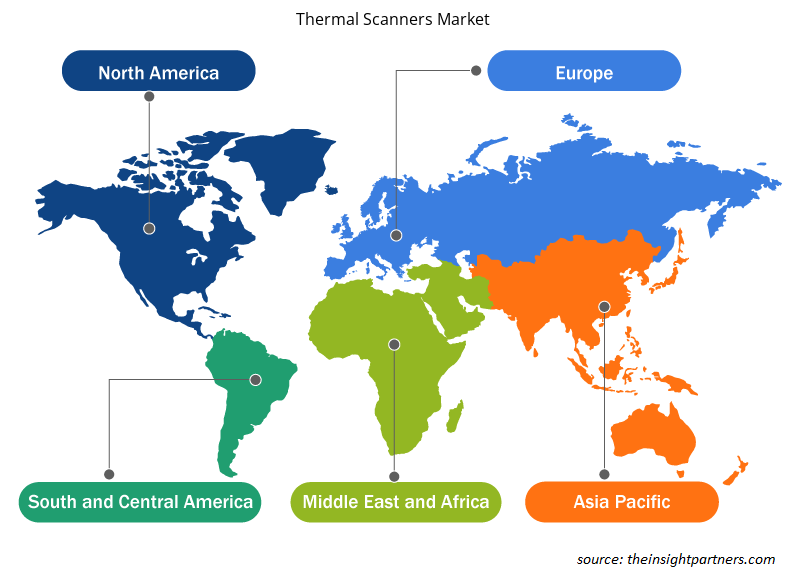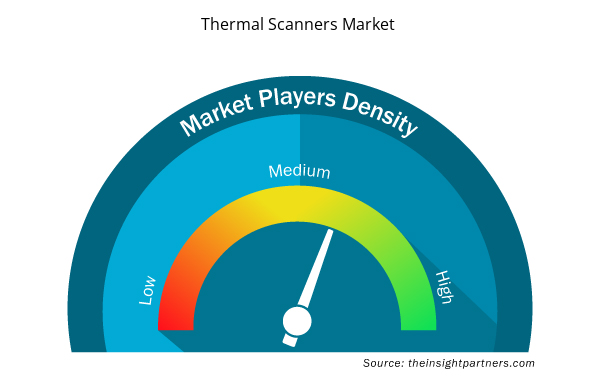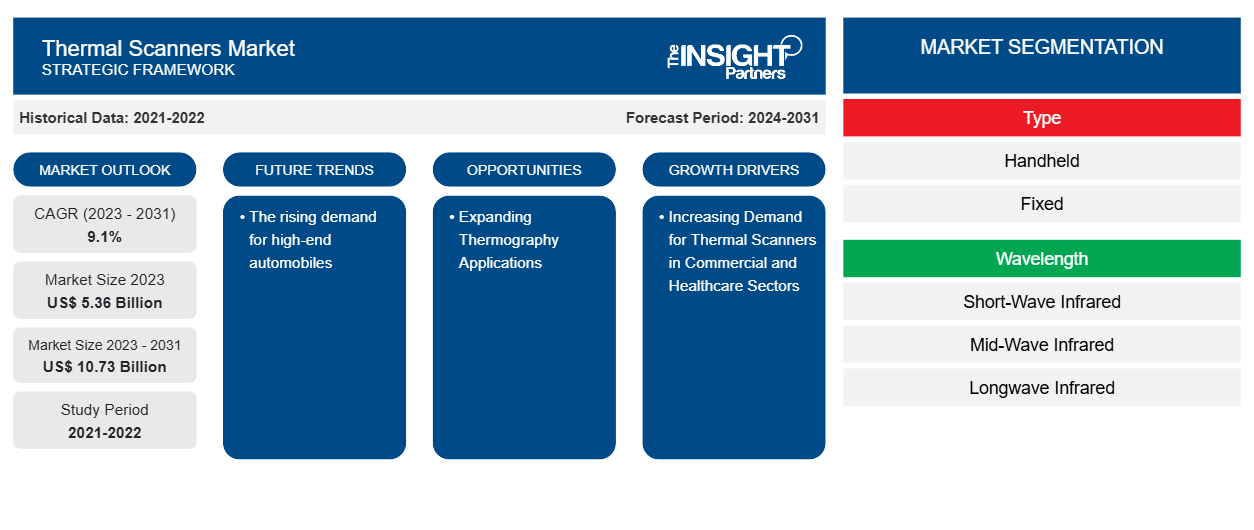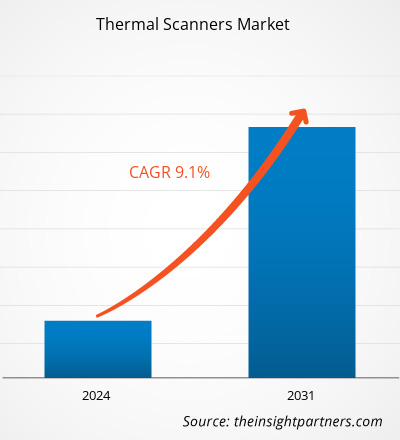Si prevede che il mercato degli scanner termici raggiungerà i 10,73 miliardi di dollari entro il 2031, passando dai 5,36 miliardi di dollari del 2023. Si prevede che il mercato registrerà un CAGR del 9,1% nel 2023-2031. La crescente domanda di automobili di fascia alta rimarrà probabilmente una tendenza chiave del mercato degli scanner termici.
Analisi di mercato degli scanner termici
Il mercato degli scanner termici sta crescendo a un ritmo rapido a causa della crescente domanda di scanner termici nei settori commerciale e sanitario e dei crescenti investimenti in ricerca e sviluppo per lo sviluppo di scanner termici innovativi. Il mercato si sta espandendo costantemente, guidato dalla crescente installazione in vari luoghi pubblici tra cui aeroporti, ospedali e altri per scopi di rilevamento. Inoltre, l'espansione delle applicazioni della termografia, i progressi tecnologici e l'integrazione di tecnologie di intelligenza artificiale e riconoscimento facciale stanno offrendo opportunità redditizie per la crescita del mercato.
Panoramica del mercato degli scanner termici
Gli scanner termici a infrarossi sono strumenti di imaging non invasivi che rilevano il calore generato da qualsiasi oggetto e lo trasformano in segnali elettrici. Le loro applicazioni sono cresciute nel tempo in una varietà di contesti, tra cui operazioni industriali, centri di trattamento terapeutico, laboratori di ricerca e forze dell'ordine, tra gli altri. La diversificazione e la crescita di molte applicazioni hanno aumentato le vendite di scanner termici in diverse economie negli ultimi anni.
Personalizza questo report in base alle tue esigenze
Riceverai la personalizzazione gratuita di qualsiasi report, comprese parti di questo report, o analisi a livello nazionale, pacchetto dati Excel, oltre a usufruire di grandi offerte e sconti per start-up e università
- Scopri le principali tendenze di mercato in questo rapporto.Questo campione GRATUITO includerà analisi di dati che spaziano dalle tendenze di mercato alle stime e alle previsioni.
Driver e opportunità di mercato degli scanner termici
La crescente domanda di scanner termici nei settori commerciale e sanitario sta guidando il mercato
Gli scanner termici sono molto richiesti nei settori commerciale e sanitario per applicazioni di sicurezza e sorveglianza. La crescente necessità di applicazioni di sicurezza e sorveglianza associata all'elevata necessità di maggiore sicurezza tra dipendenti e residenti sta guidando il mercato. Gli scanner termici offrono un elevato ritorno sull'investimento (ROI) agli utenti grazie alla loro disponibilità a basso costo rispetto ai sistemi CCTV . I costi totali di installazione di un sistema di sicurezza basato su telecamera termica sono molto inferiori a quelli di un sistema CCTV, il che ne aumenta l'adozione nei settori commerciale e sanitario. Tuttavia, si prevede che l'aumento degli investimenti in sistemi infrastrutturali da parte dei settori commerciale e sanitario, combinato con la necessità di sorveglianza professionale, guiderà il mercato.
Espansione delle applicazioni della termografia: un'opportunità nel mercato degli scanner termici
La termografia è ampiamente utilizzata nel settore medico per il monitoraggio della pressione sanguigna, la chirurgia cardiaca, la diagnosi di malattie del fegato e la rilevazione del cancro al seno, tra gli altri. L'applicazione della termografia utilizza una telecamera a infrarossi installata in uno scanner termico per aiutare a rilevare il flusso sanguigno e i modelli di calore nei tessuti corporei. Inoltre, la crescente spesa del settore medico e le crescenti attività di ricerca e sviluppo verso lo sviluppo di scanner termici avanzati stanno generando significative opportunità di crescita per il mercato durante il periodo di previsione.
Analisi della segmentazione del rapporto di mercato degli scanner termici
I segmenti chiave che hanno contribuito alla derivazione dell'analisi di mercato degli scanner termici sono tipologia, lunghezza d'onda e utilizzo finale.
- In base al tipo, il mercato degli scanner termici è diviso tra portatili e fissi. Il segmento fisso ha detenuto una quota di mercato maggiore nel 2023.
- In base alla lunghezza d'onda, il mercato degli scanner termici è suddiviso in infrarossi a onde corte, infrarossi a onde medie e infrarossi a onde lunghe. Il segmento degli infrarossi a onde lunghe ha detenuto una quota di mercato maggiore nel 2023.
- In termini di utilizzo finale, il mercato è categorizzato come industriale, aerospaziale e difesa, automobilistico, petrolio e gas e altri. Il segmento aerospaziale e difesa ha detenuto una quota di mercato maggiore nel 2023.
Analisi della quota di mercato degli scanner termici per area geografica
L'ambito geografico del rapporto di mercato sugli scanner termici è suddiviso principalmente in cinque regioni: Nord America, Asia Pacifico, Europa, Medio Oriente e Africa e Sud America/Sud e Centro America. In termini di fatturato, il Nord America ha rappresentato la quota di mercato degli scanner termici più grande, a causa dell'espansione dell'industria aerospaziale e della difesa.
Si prevede che il mercato nell'area Asia-Pacifico si espanderà nel prossimo futuro, attribuito a molti venditori che forniscono soluzioni a basso costo, il che aumenta la domanda di scanner termici tra gli utenti finali. L'aumento degli investimenti e l'espansione di numerosi settori, tra cui industriale, aerospaziale e difesa, automobilistico, petrolifero e del gas e altri, stanno creando opportunità nel mercato. Questi settori stanno adottando ampiamente gli scanner termici per scopi di sorveglianza, il che stimola la produzione di massa. Quindi, stimolando il mercato durante il periodo di previsione.
Approfondimenti regionali sul mercato degli scanner termici
Le tendenze regionali e i fattori che influenzano il mercato degli scanner termici durante il periodo di previsione sono stati ampiamente spiegati dagli analisti di Insight Partners. Questa sezione discute anche i segmenti e la geografia del mercato degli scanner termici in Nord America, Europa, Asia Pacifico, Medio Oriente e Africa e America meridionale e centrale.

- Ottieni i dati specifici regionali per il mercato degli scanner termici
Ambito del rapporto di mercato sugli scanner termici
| Attributo del report | Dettagli |
|---|---|
| Dimensioni del mercato nel 2023 | 5,36 miliardi di dollari USA |
| Dimensioni del mercato entro il 2031 | 10,73 miliardi di dollari USA |
| CAGR globale (2023-2031) | 9,1% |
| Dati storici | 2021-2022 |
| Periodo di previsione | 2024-2031 |
| Segmenti coperti | Per tipo
|
| Regioni e Paesi coperti | America del Nord
|
| Leader di mercato e profili aziendali chiave |
|
Densità degli attori del mercato degli scanner termici: comprendere il suo impatto sulle dinamiche aziendali
Il mercato degli scanner termici sta crescendo rapidamente, spinto dalla crescente domanda degli utenti finali dovuta a fattori quali l'evoluzione delle preferenze dei consumatori, i progressi tecnologici e una maggiore consapevolezza dei vantaggi del prodotto. Con l'aumento della domanda, le aziende stanno ampliando le loro offerte, innovando per soddisfare le esigenze dei consumatori e capitalizzando sulle tendenze emergenti, il che alimenta ulteriormente la crescita del mercato.
La densità degli operatori di mercato si riferisce alla distribuzione di aziende o società che operano in un particolare mercato o settore. Indica quanti concorrenti (operatori di mercato) sono presenti in un dato spazio di mercato in relazione alle sue dimensioni o al valore di mercato totale.
Le principali aziende che operano nel mercato degli scanner termici sono:
- Sistemi FLIR, Inc.
- AMETEK Inc.
- Bosch Italia S.p.A.
- 3 milioni
- Leonardo
- Industrie elettro-ottiche
Disclaimer : le aziende elencate sopra non sono classificate secondo un ordine particolare.

- Ottieni una panoramica dei principali attori del mercato degli scanner termici
Notizie di mercato e sviluppi recenti sugli scanner termici
Il mercato degli scanner termici viene valutato raccogliendo dati qualitativi e quantitativi dopo la ricerca primaria e secondaria, che include importanti pubblicazioni aziendali, dati associativi e database. Di seguito è riportato un elenco di sviluppi nel mercato degli scanner termici e delle strategie:
- A gennaio 2024, Valeo e Teledyne FLIR consegneranno la prima tecnologia di imaging termico Automotive Safety Integrity Level (ASIL) B per ADAS con visione notturna. Questo sistema completerà la vasta gamma di sensori Valeo e si affiderà allo stack software ADAS di Valeo per supportare funzioni come la frenata automatica di emergenza (AEB) di notte per veicoli passeggeri e commerciali, nonché per auto autonome. (Fonte: Valeo, comunicato stampa, 2024)
Copertura e risultati del rapporto di mercato sugli scanner termici
Il rapporto "Dimensioni e previsioni del mercato degli scanner termici (2021-2031)" fornisce un'analisi dettagliata del mercato che copre le seguenti aree:
- Dimensioni e previsioni del mercato a livello globale, regionale e nazionale per tutti i segmenti di mercato chiave coperti dall'ambito
- Dinamiche di mercato come fattori trainanti, vincoli e opportunità chiave
- Principali tendenze future
- Analisi dettagliata delle cinque forze PEST/Porter e SWOT
- Analisi di mercato globale e regionale che copre le principali tendenze di mercato, i principali attori, le normative e gli sviluppi recenti del mercato
- Analisi del panorama industriale e della concorrenza che copre la concentrazione del mercato, l'analisi della mappa di calore, i principali attori e gli sviluppi recenti
- Profili aziendali dettagliati
- Analisi storica (2 anni), anno base, previsione (7 anni) con CAGR
- Analisi PEST e SWOT
- Valore/volume delle dimensioni del mercato - Globale, regionale, nazionale
- Industria e panorama competitivo
- Set di dati Excel


- Hot Melt Adhesives Market
- Trade Promotion Management Software Market
- Truck Refrigeration Market
- Oxy-fuel Combustion Technology Market
- Europe Surety Market
- Genetic Testing Services Market
- Bio-Based Ethylene Market
- Medical Enzyme Technology Market
- Flexible Garden Hoses Market
- Nuclear Decommissioning Services Market

Report Coverage
Revenue forecast, Company Analysis, Industry landscape, Growth factors, and Trends

Segment Covered
This text is related
to segments covered.

Regional Scope
North America, Europe, Asia Pacific, Middle East & Africa, South & Central America

Country Scope
This text is related
to country scope.
Domande frequenti
The incremental growth expected to be recorded for the global thermal scanners market during the forecast period is US$ 5.37 billion.
The key players holding majority shares in the global thermal scanners market are FLIR Systems, Inc., AMETEK Inc., Robert Bosch GmbH, 3M, and Leonardo.
The global thermal scanners market is expected to reach US$ 10.73 billion by 2031.
The rising demand for high-end automobiles to play a significant role in the global thermal scanners market in the coming years.
The increasing demand for thermal scanners in commercial and healthcare sectors and increasing investment in research & development for developing innovative thermal scanners are the major factors that propel the global thermal scanners market.
The global thermal scanners market was estimated to be US$ 5.36 billion in 2023 and is expected to grow at a CAGR of 9.1% during the forecast period 2023 - 2031.
Trends and growth analysis reports related to Electronics and Semiconductor : READ MORE..
The Insight Partners performs research in 4 major stages: Data Collection & Secondary Research, Primary Research, Data Analysis and Data Triangulation & Final Review.
- Data Collection and Secondary Research:
As a market research and consulting firm operating from a decade, we have published and advised several client across the globe. First step for any study will start with an assessment of currently available data and insights from existing reports. Further, historical and current market information is collected from Investor Presentations, Annual Reports, SEC Filings, etc., and other information related to company’s performance and market positioning are gathered from Paid Databases (Factiva, Hoovers, and Reuters) and various other publications available in public domain.
Several associations trade associates, technical forums, institutes, societies and organization are accessed to gain technical as well as market related insights through their publications such as research papers, blogs and press releases related to the studies are referred to get cues about the market. Further, white papers, journals, magazines, and other news articles published in last 3 years are scrutinized and analyzed to understand the current market trends.
- Primary Research:
The primarily interview analysis comprise of data obtained from industry participants interview and answers to survey questions gathered by in-house primary team.
For primary research, interviews are conducted with industry experts/CEOs/Marketing Managers/VPs/Subject Matter Experts from both demand and supply side to get a 360-degree view of the market. The primary team conducts several interviews based on the complexity of the markets to understand the various market trends and dynamics which makes research more credible and precise.
A typical research interview fulfils the following functions:
- Provides first-hand information on the market size, market trends, growth trends, competitive landscape, and outlook
- Validates and strengthens in-house secondary research findings
- Develops the analysis team’s expertise and market understanding
Primary research involves email interactions and telephone interviews for each market, category, segment, and sub-segment across geographies. The participants who typically take part in such a process include, but are not limited to:
- Industry participants: VPs, business development managers, market intelligence managers and national sales managers
- Outside experts: Valuation experts, research analysts and key opinion leaders specializing in the electronics and semiconductor industry.
Below is the breakup of our primary respondents by company, designation, and region:

Once we receive the confirmation from primary research sources or primary respondents, we finalize the base year market estimation and forecast the data as per the macroeconomic and microeconomic factors assessed during data collection.
- Data Analysis:
Once data is validated through both secondary as well as primary respondents, we finalize the market estimations by hypothesis formulation and factor analysis at regional and country level.
- Macro-Economic Factor Analysis:
We analyse macroeconomic indicators such the gross domestic product (GDP), increase in the demand for goods and services across industries, technological advancement, regional economic growth, governmental policies, the influence of COVID-19, PEST analysis, and other aspects. This analysis aids in setting benchmarks for various nations/regions and approximating market splits. Additionally, the general trend of the aforementioned components aid in determining the market's development possibilities.
- Country Level Data:
Various factors that are especially aligned to the country are taken into account to determine the market size for a certain area and country, including the presence of vendors, such as headquarters and offices, the country's GDP, demand patterns, and industry growth. To comprehend the market dynamics for the nation, a number of growth variables, inhibitors, application areas, and current market trends are researched. The aforementioned elements aid in determining the country's overall market's growth potential.
- Company Profile:
The “Table of Contents” is formulated by listing and analyzing more than 25 - 30 companies operating in the market ecosystem across geographies. However, we profile only 10 companies as a standard practice in our syndicate reports. These 10 companies comprise leading, emerging, and regional players. Nonetheless, our analysis is not restricted to the 10 listed companies, we also analyze other companies present in the market to develop a holistic view and understand the prevailing trends. The “Company Profiles” section in the report covers key facts, business description, products & services, financial information, SWOT analysis, and key developments. The financial information presented is extracted from the annual reports and official documents of the publicly listed companies. Upon collecting the information for the sections of respective companies, we verify them via various primary sources and then compile the data in respective company profiles. The company level information helps us in deriving the base number as well as in forecasting the market size.
- Developing Base Number:
Aggregation of sales statistics (2020-2022) and macro-economic factor, and other secondary and primary research insights are utilized to arrive at base number and related market shares for 2022. The data gaps are identified in this step and relevant market data is analyzed, collected from paid primary interviews or databases. On finalizing the base year market size, forecasts are developed on the basis of macro-economic, industry and market growth factors and company level analysis.
- Data Triangulation and Final Review:
The market findings and base year market size calculations are validated from supply as well as demand side. Demand side validations are based on macro-economic factor analysis and benchmarks for respective regions and countries. In case of supply side validations, revenues of major companies are estimated (in case not available) based on industry benchmark, approximate number of employees, product portfolio, and primary interviews revenues are gathered. Further revenue from target product/service segment is assessed to avoid overshooting of market statistics. In case of heavy deviations between supply and demand side values, all thes steps are repeated to achieve synchronization.
We follow an iterative model, wherein we share our research findings with Subject Matter Experts (SME’s) and Key Opinion Leaders (KOLs) until consensus view of the market is not formulated – this model negates any drastic deviation in the opinions of experts. Only validated and universally acceptable research findings are quoted in our reports.
We have important check points that we use to validate our research findings – which we call – data triangulation, where we validate the information, we generate from secondary sources with primary interviews and then we re-validate with our internal data bases and Subject matter experts. This comprehensive model enables us to deliver high quality, reliable data in shortest possible time.


 Ottieni un campione gratuito per questo repot
Ottieni un campione gratuito per questo repot